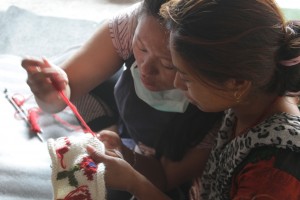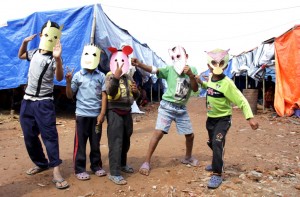Thulo Byasi update June 20,2015 There’s a beautifully knit replica of Dharahara standing on one corner of the Artree studio. It’s a work by Kala Limbu, one of the volunteers from Lalit Kala Campus who has been working with the ’12 Baishak‘ project initiated by the Artree artist collective. In a few hours it will be at the stand of Artree in a fundraising event organised by the Yellow House, Sanepa, whose proceeds are to be donated to Srijanalaya’s art camp for children. Women empowerment project For now Sheelasha Rajbhandari, one of Artree’s founding member is busy updating information about her women empowerment project under the ’12 Baishak‘ community art project. Rajbhandari excitedly shows me the work of Kesari, one of the women from Thulo Byasi, ward no-10, Bhaktapur with whom she has been working for the past month. It is a self portrait knit intricately in black and white. “ I can’t tell you how much she has transformed, she is not depressive anymore, knits at her own free will and even guides others in her class enthusiastically,” she says. Starting knitting classes for them a month ago, Rajbhandari observed that the women in the group felt powerless in their community. They were mostly daughter-in-laws whose lives revolved around their husbands and children. After the earthquake they felt even more powerless without a home and a future. So she encouraged them to express themselves through their knit work. They had been knitting all their lives but not as a way of self expression, rather to meet the product demand. She facilitated their knit work with books on new designs, brought it in knitter Kala Limbu and Ujwala Kapali, product designer for their suggestions and has been paying them to experiment with their skill.

The recent portrait exercise has made them even more confident of their skill. “ Usually a portrait is only made of famous and powerful people or Gods and asking them to experiment with it really made them feel empowered,” she says. She plans to keep encouraging their self expression and only direct them when needed. The project will continue independently as work on ‚Camp Hub‘ continues through the next weeks. Camp Hub Hitman Gurung, another Artree member arrives and informs about the regular meetings they have been having with the community and artists to be involved in ‚Camp Hub‘. The progress is that until now 12 artists who will be working in the art making process have been decided. Besides the five members of Artree (Hitman Gurung, Sheelasha Rajbhandari, Mekh Limbu, Suvash Tamang and Lavkant Chaudhary) three members of the art group ‚Devotee‘ who are based in Bhaktapur; Laxman Karmacharya, Sudip Balla and Rakesh Syakarmi including Jeevan Suwal, Balkrishna Banmala, Narayan Bohaju and Sanjeev Maharjan are working on finalizing their visual concept notes. “But there will be more artists who can be added to the list, we are looking for a local project manager and encouraging art students to volunteer in the project as well because this is a huge opportunity for them. This is not something that can be learnt in any academic course and a great platform for contemporary artists. The times will not be the same and there might not be a possibility to work with a community like this ,” says Gurung. He sees a huge potential for ‚Camp Hub‘, an event that can set a new dimension in contemporary art practice in Nepal. The work in progress of the artists will be more important than the final product and they will be documenting the process through both photography and texts. Since the art works are solely research based, artists have been busy with site study, observation and interaction. Gurung foresees August to be a busy month for the artists as they prepare their final artwork. He is also planning for a bigger event with the display. “We are in talks to turn the display moment into a larger event, perhaps a three day festival of art, music and food. There are a lot of bhajan groups around and the place is famous for its Newari cuisine,” says Gurung. Children Art Project The children art project is being co-ordinated by Lavkant Chaudhary, another Artree member whose previous art works have been based on children and their hardships He recalls the initial days of conducting art sessions for the children. They were in trauma, mistrustful of outsiders and didn’t hesitate to use abusive words. But through different art exercises they slowly started trusting him. “The mask

making exercise which we conducted for them in the first week really helped them to come out of their shells, then they became closer with us,” he says. Through motivational screenings and expression through color they have now formed a special bond with him.The art sessions includes children from three to seventeen years of age. For this week’s session he asked the children to draw their most prized possessions, the things that they felt they could have saved from their houses in the earthquake. The kids drew their computer, favorite dress to their slippers that they had left while running in the chaos of the earthquake . “ They really enjoyed it and now I see that they have come out of the post-earthquake trauma,” says Chaudhary. For his project for ‚Camp Hub‘ he is working on using the stories of the children. He has titled it ‚Bhada-kuti‘ and hopes to choose 25 kids whose individual stories he will mould into a 2D or 3D display as per their interest. “I am now collecting their individual stories,” he shares. Mekh Limbu is also working with the children in his project titled “Chala.Chitra” or moving pictures, he plans to make a rudimentary projector and project the drawings of the children in a series. To facilitate interaction between children and among adults in the camp, “ Basi Biyalo” a initiative to create a interaction space has been completed by Subas Tamang, another Artree member. He describes it as a sitting space made out of bamboo with a plastic roof that facilitates gatherings and discussions in the camp. “ It is not only a feasible place to gather but also a platform to share stories which I plan to use further for my project for Camp Hub,” he says. Since the concept of Camp Hub will be taken to other communities he wants to share the interactions and stories of the community to others. “ Maybe I will ask them to write letters to others about their experiences of the earthquake and then display in another community, they can perhaps write back or even take the letter for themselves,” he says. The whole group sees the project as a long term association with the community. As Rajbhandari put it ,“We want to evolve with the community, we want them to know what we are doing and include them in all the decisions we make.” (“12 Baishak,”is a community art project that came out as Artree: an artist collective’s response to the April 25 and May 12 earthquake in Nepal. The five members of the group with volunteers from Lalitkala Campus have been working closely with the community in Thulo Byasi- Ward no 10, Bhaktapur to ease them of their trauma. Through projects like Camp Hub which aims to turn meeting places like tea shops in the community into a space for memory and reconciliation the collective is using their artistic skills to help rebuild it. ) This report was written by Dikshya Karki, a researcher from Bhaktapur. (20.6.15)